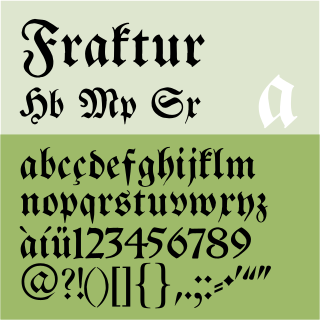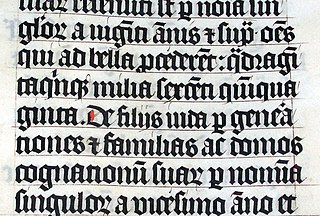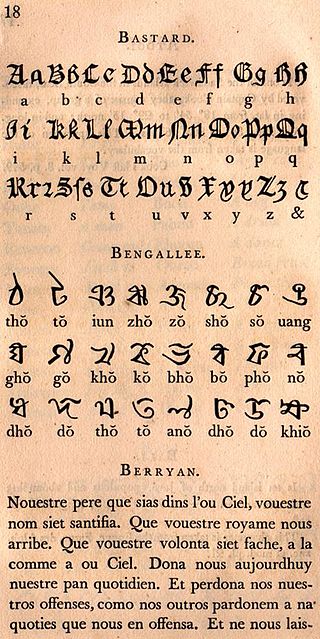
A manuscript was, traditionally, any document written by hand or typewritten, as opposed to mechanically printed or reproduced in some indirect or automated way. More recently, the term has come to be understood to further include any written, typed, or word-processed copy of an author's work, as distinguished from the rendition as a printed version of the same.
R, or r, is the eighteenth letter of the Latin alphabet, used in the modern English alphabet, the alphabets of other western European languages and others worldwide. Its name in English is ar, plural ars, or in Ireland or.
W, or w, is the twenty-third and fourth-to-last letter of the Latin alphabet, used in the modern English alphabet, the alphabets of other western European languages and others worldwide. It represents a consonant, but in some languages it represents a vowel. Its name in English is double-u, plural double-ues.

Fraktur is a calligraphic hand of the Latin alphabet and any of several blackletter typefaces derived from this hand. Letters are designed such that the individual strokes are broken apart; in this way it is often contrasted with the curves of the Antiqua (common) typefaces where the letters are designed to flow and strokes connect together in a continuous fashion. The word "Fraktur" derives from Latin frāctūra, built from frāctus, passive participle of frangere, the same root as the English word "fracture".

Carolingian minuscule or Caroline minuscule is a script which developed as a calligraphic standard in the medieval European period so that the Latin alphabet of Jerome's Vulgate Bible could be easily recognized by the literate class from one region to another. It is thought to have originated before AD 778 at the scriptorium of the Benedictine monks of Corbie Abbey, about 150 km (93 mi) north of Paris, and then developed by Alcuin of York for wide use in the Carolingian Renaissance. Alcuin himself still wrote in a script which was a precursor the Carolingian minuscule, which slowly developed over three centuries. He was most likely responsible for copying and preserving the manuscripts and upkeep of the script. It was used in the Holy Roman Empire between approximately 800 and 1200. Codices, pagan and Christian texts, and educational material were written in Carolingian minuscule.

Gothic script and Gothic font may refer to:

Blackletter, also known as Gothic script, Gothic minuscule, or Textura, was a script used throughout Western Europe from approximately 1150 until the 17th century. It continued to be commonly used for the Danish, Norwegian, and Swedish languages until the 1870s, Latvian language until the 1930s, and for the German language until the 1940s, when Hitler's distaste for the supposedly "Jewish-influenced" script saw it officially discontinued in 1941. Fraktur is a notable script of this type, and sometimes the entire group of blackletter faces is incorrectly referred to as Fraktur. Blackletter is sometimes referred to as Old English, but it is not to be confused with the Old English language, which predates blackletter by many centuries and was written in the insular script or in Futhorc. Along with Italic type and Roman type, blackletter served as one of the major typefaces in the history of Western typography.
Old English is an early form of the English language spoken by Anglo-Saxons until the 12th century.

Italic script, also known as chancery cursive and Italic hand, is a semi-cursive, slightly sloped style of handwriting and calligraphy that was developed during the Renaissance in Italy. It is one of the most popular styles used in contemporary Western calligraphy.

The German word Schwabacher refers to a specific style of blackletter typefaces which evolved from Gothic Textualis (Textura) under the influence of Humanist type design in Italy during the 15th century. Schwabacher typesetting was the most common typeface in Germany, until it was replaced by Fraktur from the mid 16th century onwards.

The Antiqua–Fraktur dispute was a typographical dispute in 19th- and early 20th-century Germany.

Secretary hand or script is a style of European handwriting developed in the early sixteenth century that remained common in the sixteenth and seventeenth centuries for writing English, German, Welsh and Gaelic.

Bastarda or bastard was a blackletter script chiefly used in France, the Burgundian Netherlands and Germany during the 14th and 15th centuries. The Burgundian variant of script can be seen as the court script of the Dukes of Burgundy. The particularly English forms of the script are sometimes distinguished as Bastarda Anglicana or Anglicana.

The term "chancery hand" can refer to either of two distinct styles of historical handwriting.
In typography, the Vox-ATypI classification makes it possible to classify typefaces into general classes. Devised by Maximilien Vox in 1954, it was adopted in 1962 by the Association Typographique Internationale (ATypI) and in 1967 as a British Standard, as British Standards Classification of Typefaces, which is a very basic interpretation and adaptation/modification of the earlier Vox-ATypI classification. On April 27, 2021, ATypI announced that they had de-adopted the system and that they were establishing a working group building towards a new, larger system incorporating the different scripts of the world.
Gothic writing may refer to
Gothic or Gothics may refer to:

Court hand was a style of handwriting used in medieval English law courts, and later by professionals such as lawyers and clerks. "It is noticeably upright and packed together with exaggeratedly long ascenders and descenders, the latter often and the former occasionally brought round in sweeping crescent shaped curves".
B, or b, is the second letter of the Latin-script alphabet, used in the modern English alphabet, the alphabets of other western European languages and others worldwide. Its name in English is bee, plural bees. It represents the voiced bilabial stop in many languages, including English. In some other languages, it is used to represent other bilabial consonants.

Ronde is a kind of script in which the heavy strokes are nearly upright, giving the characters when taken together a round look. It appeared in France at the end of the 16th century, growing out from a late local variant of Gothic cursive influenced by N. Italian Renaissance types in Rotunda, a bookish round Gothic style, as well as Civilité, also a late French variant of Gothic cursive. It was popularized by writing masters such as Louis Barbedor in the 17th century.












